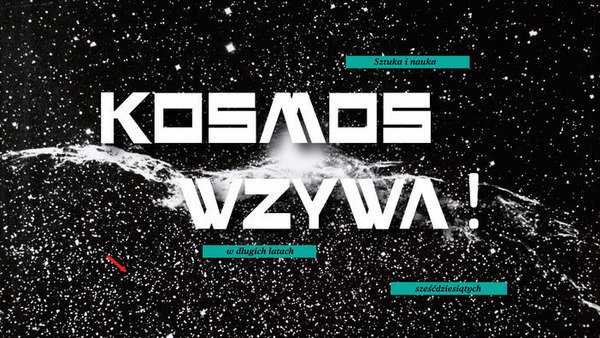Cosmos Calling!
dal 30/6/2014 al 27/9/2014
Segnalato da
30/6/2014
Cosmos Calling!
Zacheta National Gallery of Art, Warsaw
Art and Science in the Long Sixties. Besides designs for industry, the show features artistic/applied works that served as a critique of the technocratic system and contested the role that the communist authorities envisaged for design.

With the onset of the post-Stalin ‘thaw’ in the Eastern Bloc countries and the proclamation of a scientific-technological revolution, science and technology became an important weapon in Cold War rivalries on both sides of the Iron Curtain, causing space flight, modern telecommunications and nuclear energy to emerge as the symbols of the following decade. New scientific disciplines, including astronautics and the literal ‘detachment from the earth’ it made possible, as well as the impact of cybernetics (now rehabilitated in the communist bloc) and its related disciplines such as biocybernetics, robotics or artificial intelligence, shaped the collective imagination and provided a strong inspiration for all artistic disciplines, from painting, sculpture and music to design, architecture and urban planning.
The genre of science fiction, experiencing a revival at the time, and a widespread fascination with scientific discoveries created an important context for the presentation of the era’s experimental designs and artworks. The ‘space race’ contributed to the development of architectural utopias, and the various visions of ‘cities of the future’ were informed by the idea that humans would soon be able to live anywhere on Earth or in space. The scientific-technological revolution was also influential in changing the perception of the human body and its new, expanded, perceptual capabilities. An important theme of 1960s art was the exploration and testing of sensory perception – from kinetic art and op art, through experimental electronic music, to ‘multisensory space’ environments.
The exhibition presents artists’ ambiguous ties, exploited by communist propaganda, with science, technology and industry. Whereas the idea, popular as a leitmotif of 1960s retreats and symposiums, of collaboration between artists and scientists remained confined to paper, industrial design was a field where it had a chance to be fulfilled, if only to a limited degree. Besides designs for industry, the show features artistic/applied works that served as a critique of the technocratic system and contested the role that the communist authorities envisaged for design.
Artists: Andrzej Bertrandt, Ewa Bończa-Tomaszewska, Włodzimierz Borowski, Barbara Braumann, Wojciech Bruszewski, Chanéac, Jan Chwałczyk, Emil Cieślar, Roman Cieślewicz, Viola Damięcka , Wojciech Fangor, Jerzy Fedorowicz, Karol Ferster, Stano Filko, Yona Friedmann, Jan Głuszak, Wanda Gołkowska, Krzysztof Gordon, Jadwiga Grabowska-Hawrylak, grupa | group Miasto, Oskar Hansen, Pascal Häusermann, Alfred Hirschmeier, Zdzisław Jurkiewicz, Teresa Józefowicz, Stanisław Kokesz, Július Koller, Grzegorz Kowalski, Rafał Kwinto, Janusz Kubik, Romuald Kutera, Paweł Kwiek, Andrzej Latos, Benon Liberski, Kurt Maetzig, Janusz Majewski, Andrzej Markowski, Viera Mecková, Alex Mlynárčik, Daniel Mróz, Bohdan Mazurek, Maria Michałowska, Józef Mroszczak, Stefan Müller, Marek Nowicki, Andrzej Pawłowski, Krzysztof Penderecki, Werner Pieske, Jindřich Polák, Janusz Połom, Ludmiła Popiel, Julian Raczko, Anatol Radzinowicz, Józef Robakowski, Jerzy Rosołowicz, Teodor Rotrekl, Eugeniusz Rudnik, Olgierd Rutkowski, Andrzej Sadowski, Ryszard Semka, Stanisław Siemek, Janusz Star, Jerzy Stawicki, Witold Surowiecki, Maria Syska, Kaja Szymańska, Lech Tomaszewski, Urbański Kazimierz, Andrzej Wajda, Ryszard Waśko, Andrzej Wiernicki, Ryszard Winiarski, Krzysztof Wodiczko, Andrzej Jan Wróblewski, Wojciech Zamecznik, Stanisław Zagórski, Krzysztof Zanussi, Gustaw Zemła, Jan Ziemski
curators: Joanna Kordjak-Piotrowska, Stanisław Welbel
collaboration: Magdalena Komornicka, Jacek Świdziński
Due to a specific architecture of the exhibition, we advise caution, especially when visiting with children. All children during the visit, especially when entering the part of the exhibition displayed on a raised platform, must be under adult supervision. Visitors with children are entering the platform at their own risk.
partners of the exhibition: Filmoteka Narodowa, Instytut Słowacki
cooperation: Studio Filmowe KADR, Wytwórnia Filmów Oświatowych
partners of the gallery: Lidex, Kancelaria Malinowski, Płachta i Wspólnicy. Radcowie prawni i adwokaci sponsors of the opening ceremony: DeLonghi, Kenwood, Freixenet
media patronage: The Warsaw Voice, Stolica, Artinfo.pl
Press contact
Olga Gawerska phone 48 22 556 96 55 mobile phone 0 603 510 112 rzecznik@zacheta.art.pl
Marta Miś-Michalska phone 48 22 556 96 54 m.mis-michalska@zacheta.art.pl
Zachęta National Gallery of Art
pl. Małachowskiego 3 00-916 Warsaw
Hours: Tuesday–Sunday noon–8pm,
Free admission on Thursday



